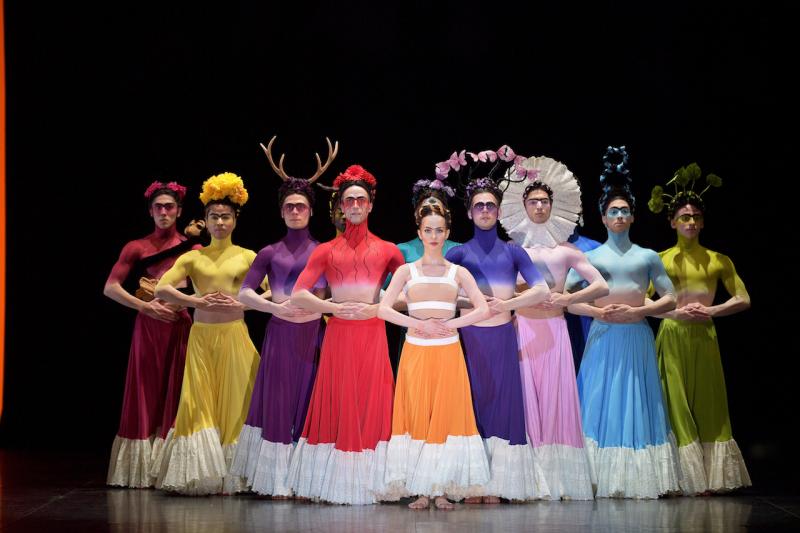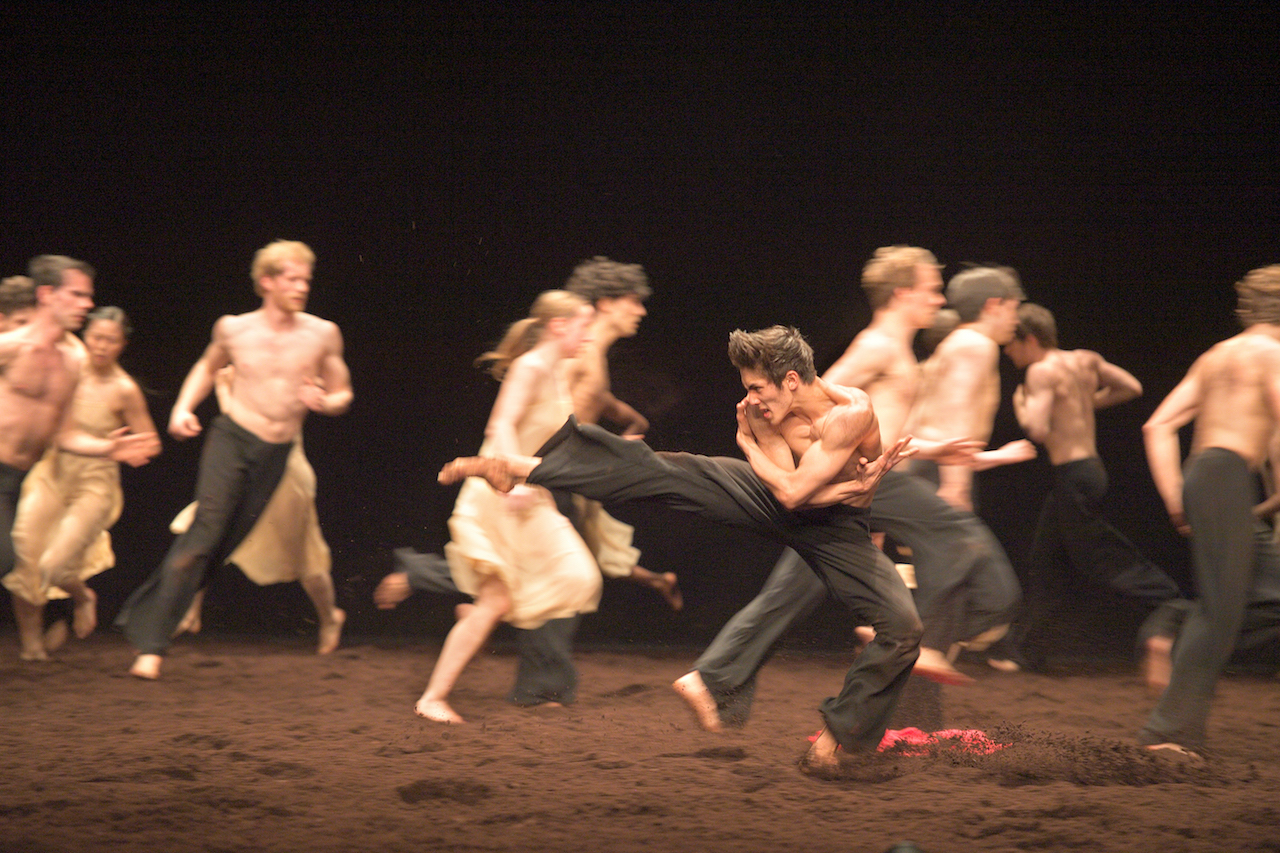She Persisted, English National Ballet, Sadler's Wells review - a must-see triple bill | reviews, news & interviews
She Persisted, English National Ballet, Sadler's Wells review - a must-see triple bill
She Persisted, English National Ballet, Sadler's Wells review - a must-see triple bill
ENB hit another high with a storming Rite of Spring

She does indeed persist, that remarkable Tamara Rojo. Dismayed by the fact that, in 20 years as a dancer, she had never performed a ballet made by a woman, she mounted a triple bill called She Said, featuring only work by and about women.
Stina Quagebeur, a dancer with ENB making her choreographic debut on a big stage, certainly knows how to move bodies around. She also shows confidence as a narrator, stripping Ibsen’s plot to the bone: Nora fields just three protagonists and a small chorus as the heroine’s conscience. The resulting drama is taut as a bow, and it feels short – always a plus with a newbie.
Crystal Costa’s heroine is all flowery arms and girlish compliance with her husband Torvald (Jeffrey Cirio) until a moment of truth makes her see that his patronising has kept her in a state of permanent adolescence. So far so good. But plot complications such as blackmail are a no-go in wordless drama, and that’s where this ballet, for all its fluency, comes unstuck. Those unfamiliar with the play won’t have a clue when dastardly bank clerk Krogstad (Junor Souza in a fabulous egg-yolk-yellow suit) turns up looking threatening. As for the accompanying music, you either love or loathe the arpeggiated tedium of Philip Glass, but it’s a shame when choreography falls into step with that four-square doggedness. An exception is when Torvald discovers that his child-wife plans to leave him. No four-bar phrasing here, nor obstacles to comprehension: this is alpha-male fury writ large and briefly, we're gripped.
Annabelle Lopez Ochoa is an older hand at this game, and her exuberant bio-ballet of the Mexican painter Frida Kahlo takes all kinds of risks with pace and narrative loopiness that only experience can deliver. Set to a compelling score by Peter Salem dominated by cool marimba and chilli-spiked Tijuana trumpet, it begins with Kahlo as a lively schoolgirl cavorting with skeletons. These Day of the Dead ciphers are not so much grim reapers as mischievous reminders of the twists fate can take. Cue a life-changing traffic accident – ingeniously suggested by screeching and headlamp glare. Isolated and in pain, strapped to a hospital bed for months, Kahlo envisions herself, monobrow and all, in a parade of fantastical beings: as a deer, as a butterfly, as a man, as any number of exotic plants and flowers … It’s these flights of visual zaniness (design: Dieweke van Reij, drawing on Kahlo’s paintings) that ultimately make Broken Wings memorable.
On this revival, Katja Khaniukova takes the role of the spirited Khalo. Veteran Irek Mukhamedov reprises his clownish turn as the roly-poly Diego Rivera, her unfaithful husband. It’s a measure of Tamara Rojo’s directoral bold ambition that she secured the rights from the Pina Bausch estate for ENB to dance her Rite of Spring (pictured above). Since its creation in 1975 only Paris Opera Ballet and Bausch’s own company had been allowed to do it. And for a purely classical company the challenge is immense. Decorousness and grace go out of the window. Here the dancers must adopt an earthy weightedness animated by fear, bewilderment and fury. Movement alternates between savage running, falling, cowering, huddling, manic self-flagellation and simulated copulation. The thick layer of peat that covers the stage soon transfers to sweating bodies.
It’s a measure of Tamara Rojo’s directoral bold ambition that she secured the rights from the Pina Bausch estate for ENB to dance her Rite of Spring (pictured above). Since its creation in 1975 only Paris Opera Ballet and Bausch’s own company had been allowed to do it. And for a purely classical company the challenge is immense. Decorousness and grace go out of the window. Here the dancers must adopt an earthy weightedness animated by fear, bewilderment and fury. Movement alternates between savage running, falling, cowering, huddling, manic self-flagellation and simulated copulation. The thick layer of peat that covers the stage soon transfers to sweating bodies.
What’s it about? You can read Rite as a pre-Christian redemption story: the saving of the tribe by the sacrifice of a single life. You can read it as a critique of mankind’s irredeemable bestiality. Whatever, there are moments when the exhausted panting of 28 wrung-out human beings is terrible to hear, and watching feels like voyeurism, not least when the Chosen One (the deceptively fragile-looking Francesca Velicu in the performance I saw) dances to the point of collapse.
Perhaps the most fascinating element of Bausch’s stagecraft is the way she counterpoints individuals and the mass, or rather masses: male and female. She herds them as if they were so many sheep or horses, and they respond in kind, complying and then panicking, often protecting other members of the group. The sight is stirring and touching at some very deep level.
ENB's uniformly young dancers may not deliver the same experience that Bausch's own group did (look up Wim Wenders' 2011 film Pina to get the idea), but they give this everything they've got. Igor Stravinsky’s explosive score is masterfully driven by Gavin Sutherland, conducting the ENB Philharmonic. See this now or live to regret it: there’s unlikely to be another chance for a long while.
rating
Share this article
The future of Arts Journalism
You can stop theartsdesk.com closing!
We urgently need financing to survive. Our fundraising drive has thus far raised £49,000 but we need to reach £100,000 or we will be forced to close. Please contribute here: https://gofund.me/c3f6033d
And if you can forward this information to anyone who might assist, we’d be grateful.

Subscribe to theartsdesk.com
Thank you for continuing to read our work on theartsdesk.com. For unlimited access to every article in its entirety, including our archive of more than 15,000 pieces, we're asking for £5 per month or £40 per year. We feel it's a very good deal, and hope you do too.
To take a subscription now simply click here.
And if you're looking for that extra gift for a friend or family member, why not treat them to a theartsdesk.com gift subscription?
more Dance
 'We are bowled over!' Thank you for your messages of love and support
Much-appreciated words of commendation from readers and the cultural community
'We are bowled over!' Thank you for your messages of love and support
Much-appreciated words of commendation from readers and the cultural community
 R:Evolution, English National Ballet, Sadler's Wells review - a vibrant survey of ballet in four acts
ENB set the bar high with this mixed bill, but they meet its challenges thrillingly
R:Evolution, English National Ballet, Sadler's Wells review - a vibrant survey of ballet in four acts
ENB set the bar high with this mixed bill, but they meet its challenges thrillingly
 Like Water for Chocolate, Royal Ballet review - splendid dancing and sets, but there's too much plot
Christopher Wheeldon's version looks great but is too muddling to connect with fully
Like Water for Chocolate, Royal Ballet review - splendid dancing and sets, but there's too much plot
Christopher Wheeldon's version looks great but is too muddling to connect with fully
 iD-Reloaded, Cirque Éloize, Marlowe Theatre, Canterbury review - attitude, energy and invention
A riotous blend of urban dance music, hip hop and contemporary circus
iD-Reloaded, Cirque Éloize, Marlowe Theatre, Canterbury review - attitude, energy and invention
A riotous blend of urban dance music, hip hop and contemporary circus
 How to be a Dancer in 72,000 Easy Lessons, Teaċ Daṁsa review - a riveting account of a life in dance
Michael Keegan-Dolan's unique hybrid of physical theatre and comic monologue
How to be a Dancer in 72,000 Easy Lessons, Teaċ Daṁsa review - a riveting account of a life in dance
Michael Keegan-Dolan's unique hybrid of physical theatre and comic monologue
 A Single Man, Linbury Theatre review - an anatomy of melancholy, with breaks in the clouds
Ed Watson and Jonathan Goddard are extraordinary in Jonathan Watkins' dance theatre adaptation of Isherwood's novel
A Single Man, Linbury Theatre review - an anatomy of melancholy, with breaks in the clouds
Ed Watson and Jonathan Goddard are extraordinary in Jonathan Watkins' dance theatre adaptation of Isherwood's novel
 Peaky Blinders: The Redemption of Thomas Shelby, Rambert, Sadler's Wells review - exciting dancing, if you can see it
Six TV series reduced to 100 minutes' dance time doesn't quite compute
Peaky Blinders: The Redemption of Thomas Shelby, Rambert, Sadler's Wells review - exciting dancing, if you can see it
Six TV series reduced to 100 minutes' dance time doesn't quite compute
 Giselle, National Ballet of Japan review - return of a classic, refreshed and impeccably danced
First visit by Miyako Yoshida's company leaves you wanting more
Giselle, National Ballet of Japan review - return of a classic, refreshed and impeccably danced
First visit by Miyako Yoshida's company leaves you wanting more
 Quadrophenia, Sadler's Wells review - missed opportunity to give new stage life to a Who classic
The brilliant cast need a tighter score and a stronger narrative
Quadrophenia, Sadler's Wells review - missed opportunity to give new stage life to a Who classic
The brilliant cast need a tighter score and a stronger narrative
 The Midnight Bell, Sadler's Wells review - a first reprise for one of Matthew Bourne's most compelling shows to date
The after-hours lives of the sad and lonely are drawn with compassion, originality and skill
The Midnight Bell, Sadler's Wells review - a first reprise for one of Matthew Bourne's most compelling shows to date
The after-hours lives of the sad and lonely are drawn with compassion, originality and skill
 Ballet to Broadway: Wheeldon Works, Royal Ballet review - the impressive range and reach of Christopher Wheeldon's craft
The title says it: as dancemaker, as creative magnet, the man clearly works his socks off
Ballet to Broadway: Wheeldon Works, Royal Ballet review - the impressive range and reach of Christopher Wheeldon's craft
The title says it: as dancemaker, as creative magnet, the man clearly works his socks off
 The Forsythe Programme, English National Ballet review - brains, beauty and bravura
Once again the veteran choreographer and maverick William Forsythe raises ENB's game
The Forsythe Programme, English National Ballet review - brains, beauty and bravura
Once again the veteran choreographer and maverick William Forsythe raises ENB's game

Add comment